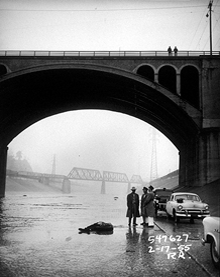The City Records Center in downtown Los Angeles is an immense repository where 150 years' worth of city documents is held. Amid the 47,500 square feet of cardboard crates filled with paperwork and other bureaucratic detritus lies a vast collection of photographs taken by Los Angeles police officers and criminologists. Many of these images come from the Scientific Investigation Division, the nation's oldest crime lab, which was established in the 1920s. It is estimated that there are over one million images in storage.
In 2001, a convergence of interests brought Merrick Morton, a photographer and LAPD reserve officer, together with the adjutant to Chief of Police Bernard C. Parks, Lieutenant John Thomas, who has researched and written articles on LAPD history. Morton had been searching for LAPD photographs for an exhibition he was planning at Fototeka, the gallery he owned with his wife, Robin Blackman. After searching the Los Angeles Police Historical Society's collection and not finding what he was looking for, he approached Lt. Thomas to help him gain access to the records department, where he was convinced he would find the sought-after images. Thomas brought Morton's request to Parks, who was happy to oblige.
Morton, Blackman, and Thomas, along with Tim B. Wride, associate curator of photography at the Los Angeles County Museum of Art and co-curator of the Fototeka show, were given unprecedented access to this immense archive of photographs. Along the way, they found themselves in the position to preserve an important piece of Los Angeles history. When it was discovered that some of the boxes contained decomposing cellulose nitrate negatives, a serious fire hazard, the Fire Department recommended that all the negatives be destroyed. The team lobbied for the archive to be only selectively destroyed and their efforts paid off; some boxes of images were determined to be unsalvageable and destroyed, while the remaining images were sent to a cold storage facility where they reside today.
This catalog is the result of hundreds of hours of sifting through countless boxes tightly packed with everyday dimestore #10 white letter envelopes, sealed and cut in half to make a convenient open-ended pouch, each containing the forensic negatives for a single case. On most of the envelopes is a hand-written "Division of Report", or DR, number. The DR number uniquely identifies each case and often appears hand-written directly on the negatives. The name or initials of the photographer can also be seen on many of the negatives.
The earliest photographs in the collection date to 1925. The film used was large-format (4"x5") cellulose nitrate until sometime in the early forties when it was replaced with safety film. In the early sixties, the size changed to medium-format (2-1/4"x2-1/4") which was used until the mid-seventies when it was, in turn, replaced with 35mm.
